In addition to increased reliability, the supported processors increase security capabilities at the chip level. These processors provide virtualization extensions and virtualization performance improvements. Windows 11 supports virtualization-based security which enables several security capabilities, including memory integrity, also known as hypervisor-protected code integrity .
HVCI disables dynamic code injection into the Windows kernel. HVCI also provides driver control and ensures that all drivers loaded meet a policy of allowed drivers set by Microsoft and the user. The United States Department of Defense requires virtualization-based security on Windows 10 for their devices. In partnership with our OEM and silicon partners, we will be enabling VBS and HVCI on most new PCs over this next year.
And we will continue to seek opportunities to expand VBS across more systems over time. Windows 11 version 21H2 was released with a ton of new features, security improvements that focus on productivity and more. Microsoft has confirmed Windows 11 is a free upgrade for all eligible Windows 10 devices, but not for all.
Your device must meet Windows 11 system requirements and bypass the PC health checkup tool before the update to appear in the usual windows update section under settings on your computer. So if you want to get this free upgrade, you must check and confirm whether your device is ready for the new windows 11. Here in this post guide how to check if your PC can run Windows 11 or your device is eligible for Windows 11 free upgrade.
Windows 11 continues our strong commitment to compatibility. This means that devices can upgrade to Windows 11 and critical apps and devices will simply work. Raising the Windows 11 minimum system requirements enables us to better support apps and hardware for drivers and devices.
Feedback also shows us that unsupported hardware is more likely to have older drivers that are incompatible with new OS features such as VBS. Supported hardware also comes with modern drivers, which helps ensure not only the reliability we mentioned earlier, but also great hardware compatibility. If you meet all the hardware requirements for running Windows 11 and still get the same error, it's most likely to do with the CPU. Microsoft has released a list of Windows 11-compatible processors for both Intel and AMD. From the looks of it, major Intel Core processors such as i3, i5, i7, i9, etc., are supported, but you must be running an 8th-Gen or above CPU to install Windows 11, which is a shocker. Basically, if you have an Intel processor below 8th-gen, you won't pass the Windows 11 compatibility test.
The bigger problem is custom-built PCs, which often have these security features turned off by default and don't always make it clear how to turn them on. One solution might be to install a newer BIOS update—many of the motherboard makers are changing their default settings in recent BIOS versions to support Windows 11 out of the box. However, at the same time, folks at The Verge claimed the PC Health Check app suggested one of the gaming PCs with a 7th Gen Intel Core i7 processor is not compatible with Windows 11. This is contradictory because Windows 11 was running just fine on the PC. Microsoft did say previously that it will not stop users from installing Windows 11 on older CPUs.
However, it will not roll out Windows Updates to these machines. This includes security updates, as well, which means Microsoft will not be liable if your PC catches a security threat. That is a big issue considering security updates are essential for a Windows machine to run.
For those who are using a PC that won't upgrade, and who aren't ready to transition to a new device, Windows 10 is the right choice. We will support Windows 10 through October 14, 2025 and we recently announced that the next feature update to Windows 10 is coming later this year. Whatever you decide, we are committed to supporting you and offering choice in your computing journey.
If you want to see the full Windows 11 minimum system requirements, you can visit this page. Following the results of our testing, we are making a small number of additions to the compatible processor list , but otherwise will maintain the minimum system requirements as originally set. The purpose of the PC Health Check app is to let users know if their PC will support Windows 11 or not.
This includes checking various aspects of the computer, such as the processor type, TDM security standard, minimum RAM and storage requirement, among others. The most important thing here is the processor, which strictly needs to be in Microsoft's list of compatible processors. A lot of processors from Intel and AMD are not supported, so it is understandable if the PC Health Check app calls your PC incompatible.
Some of the Windows 11 upgrade and installation issues are common and seem to be wide spread. Some issues can be corrected quite easily, like enabling TPM on a device if it is supported. There may also be options to install more RAM or more hard drive space. Replacing the processor may not be as simple, as it may include getting a new motherboard if the old one does not support newer processor generations. Since Windows 11 requires complete reinstallation, computers may also experience other problems that are not caused by the new version.
Instead, the upgrade process may get stuck or fail because of driver issues, incompatible applications, device drivers, custom configurations, or problems with some pieces of hardware. Get the details and see if there are things you can do in the PC Health Check app". Apperently cpu gen requirement is concerned by "intel TXT" . I have a gen 7 cpu which has tpm 2 and secure boot but doesnt have TXT . Can't microsoft validate the operating in other way since my pc meets other requirements . It just keeps on checking 1000 times , and i had times when the operating system decided it is not legit while it was .
Microsoft has finally unveiled the much-rumored Windows 11 at its event, and it looks really promising in terms of visual changes and feature set. It comes with a new Start menu, a centered taskbar, a brand new Microsoft Store, and Android app support on Windows 11, among other things. Along with that, Microsoft also released a PC Health Check app that lets you check if your PC can run Windows 11. That said, many users are reporting that even modern Windows 10 PCs are getting the "This PC Can't Run Windows 11" error.
So we looked into this issue and have come with a fix and a possible explanation behind this error. If you use VirtualBox, virtual machines won't start after the upgrade to Windows 11, and you may receive an error. The error occurs because of an incompatible issue between VirtualBox and Windows 11 when you have Hyper-V installed on the computer. Microsoft is aware of the problem, and the company confirms that Oracle is expected to release an update to fix this problem sometime in October. Also, there are those problems that are direct results of bugs with the new version.
For instance, the installation may fail because of a compatibility issue with an app or hardware, or these problems could be related to drivers and security software like antivirus. All the modern PCs have the UEFI Secure Boot and the TPM 2.0 chips features. Both the features can be enabled from the BIOS settings. Boot your PC or Laptop into the BIOS settings by tapping their BIOS keys on the startup.
Their BIOS keys may vary from F1, F2, F10, F12, and Delete. Once you are into the BIOS, enable the UEFI Secure Boot option by going into the Boot tab. Either you have to disable the Legacy Boot or enable the UEFI option. Verify the boot mode by searching for the System Information app in the Start Menu, the BIOS Mode will be listed in the left panel.
The app also provides details on backup and sync user data via Microsoft OneDrive and helps you stay updated on Windows 10 — in case you aren't moving to Windows 11 for any reason. Quickly after the app's initial release, Microsoft today updated the Windows 11 PC Health Check app. The initial version was heavily criticized by upset users for not providing the actual reason of the device incompatibility. There is a galore of modern, fresh devices which the utility has rated as not compatible with Windows 11. However, it's quite possible to run Windows 11 on a PC that doesn't meet all the minimum requirements. This is probably just one of many ways Microsoft is going to try and nudge people toward upgrading to Windows 11.
The software launched earlier this month on new PCs, and as a free upgrade for some Windows 10 users. Existing machines will be upgraded slowly, so most people haven't gotten a prompt to upgrade yet. However, Microsoft says this process is intentionally cautious. PCs will be upgraded in batches while Microsoft monitors any problems that arise.
If you wait for Microsoft's prompt, you might not have Windows 11 until next year. If you're itching to upgrade though, you can manually install the update on a compatible system by heading to Microsoft's site and getting the installation assistant. You can close the process in question and restart the setup to resolve the issue. Using a clean boot to restart the setup or remove the app causing the problem could help continue the installation. After carefully analyzing the first generation of AMD Zen processors in partnership with AMD, together we concluded that there are no additions to the supported CPU list. We will be updating the PC Health Check app to identify the correct systems with the newly added Intel CPUs in the coming weeks before the tool is released for general availability.
Microsoft has also announced in past that all Windows 10 devices which meets system requirements for Windows 11, will be eligible for free upgrade offer to Windows 11. It means if your Windows 10 device supports Windows 11 hardware specifications, you'll be able to upgrade to Windows 11 for free once it's released to public later this year. The latest Windows 10 20H1 version will even be required to upgrade to Windows 11. Just like the current Windows 10, Windows 11 will also include the monthly quality updates and yearly feature updates. Even the latest security patches will be installed along with the monthly quality updates. The PC Health Check app also includes the Updates section, make sure auto-updates are enabled by default to receive the latest updates.
Recently Microsoft Added the button to check for Windows 11 support on the PC. It scans for all the basic requirements such as Processor, GPU, Storage, RAM, TPM, UEFI, and DirectX 12. Will give you the positive result of This PC can run Windows 11 or Not by popping appropriate error.
We will also cover all the possible fixes on errors of TPM, Secure Boot, Storage, and Processor. So let's get started with downloading and installing the app on your Windows 10. The app also allows users to manage startup programs and provides tips to improve overall PC health and performance. Microsoft is offering Windows 11 to newer PCs with Windows 10 installed. It will use data to figure out when other PCs will get the upgrade.
This is similar to how Microsoft has determined which devices received Windows 10 features updates for the past few years. And it's different than how Apple handles updates since Microsoft has to work with lots of partners that also sell Windows computers. Microsoft will itself provide Windows 11 updates to Windows Insiders who don't meet the requirements, so there is definitely a way to run Windows 11 on unsupported devices. We just need to wait and see if Microsoft decided to ease the restrictions as we go along or the developer community finds ways to install Windows 11 on unsupported machines (barring 32-bit PCs). As far as I can tell, older CPUs are more than capable to run Windows 11. Microsoft has unveiled Windows 11 and it is set to arrive in Fall 2021.
The biggest question is whether you can install or upgrade from Windows 7 or Windows 10 to Windows 11 or not. Fortunately, Microsoft has released the PC Health Check app to check and inform whether your computer can run Windows 11 or not. But, many users are viewing an error upon running the app that says 'This PC can't run Windows 11' on the systems that are barely a couple of years old.
But in its current form, the PC Health Check app doesn't offer anything groundbreaking. Meanwhile, a separate button in the app called "Tips on PC health" simply advises you to turn on the built-in antivirus and to use Microsoft Edge for better internet browsing. After you complete the steps, the required files will be repaired, and Windows Update should start working to download and install the first semi-annual update of Windows 10. Microsoft has released an app that will check your for compatibility issues to see if it can run Windows 11. The first addresses the issue where functional L3 cache latency increases in some applications.
For this problem, Microsoft has released a new Windows 11 software update, KB , which you should download and install. You can do this via the Windows Update app in Windows 11. TheUEFI Secure Boot requirement ensures that a system boots with only code signed by either the device builder, the silicon vendor, or Microsoft.
It does this by ensuring all code is signed by specific entities and by recording cryptographic hashes in hardware that can also be sent to the cloud to verify integrity. If a system can be compromised prior to the operating system boot, then all kernel, user and endpoint security tools can be completely undermined. The "NotPetya" attack, which cost hundreds of millions in damages, leveraged legacy bios to inject ransomware code before boot, which can now be mitigated by Secure Boot.
The value and best practices of Secure Boot have also been validated by the U.S. We have been requiring OEMs to ship using UEFI Secure Boot enabled since June 26, 2013 and want all Windows 11 devices to be able to provide that customer benefit. In June, we heard your questions about how we set the Windows 11 minimum system requirements and shared more information on the established principles that guided us in setting them.
And as a team, we committed to exploring through Windows Insider testing and with OEMs whether there were devices running on Intel 7th Generation and AMD Zen 1 processors that met our principles. This is not the case with me I assume it has something to do with disk space available, but that is not something that windows 11 installation assistant or health check app informed me about. So I have no clue as to what the exact problem is and its frustrating to say the least.


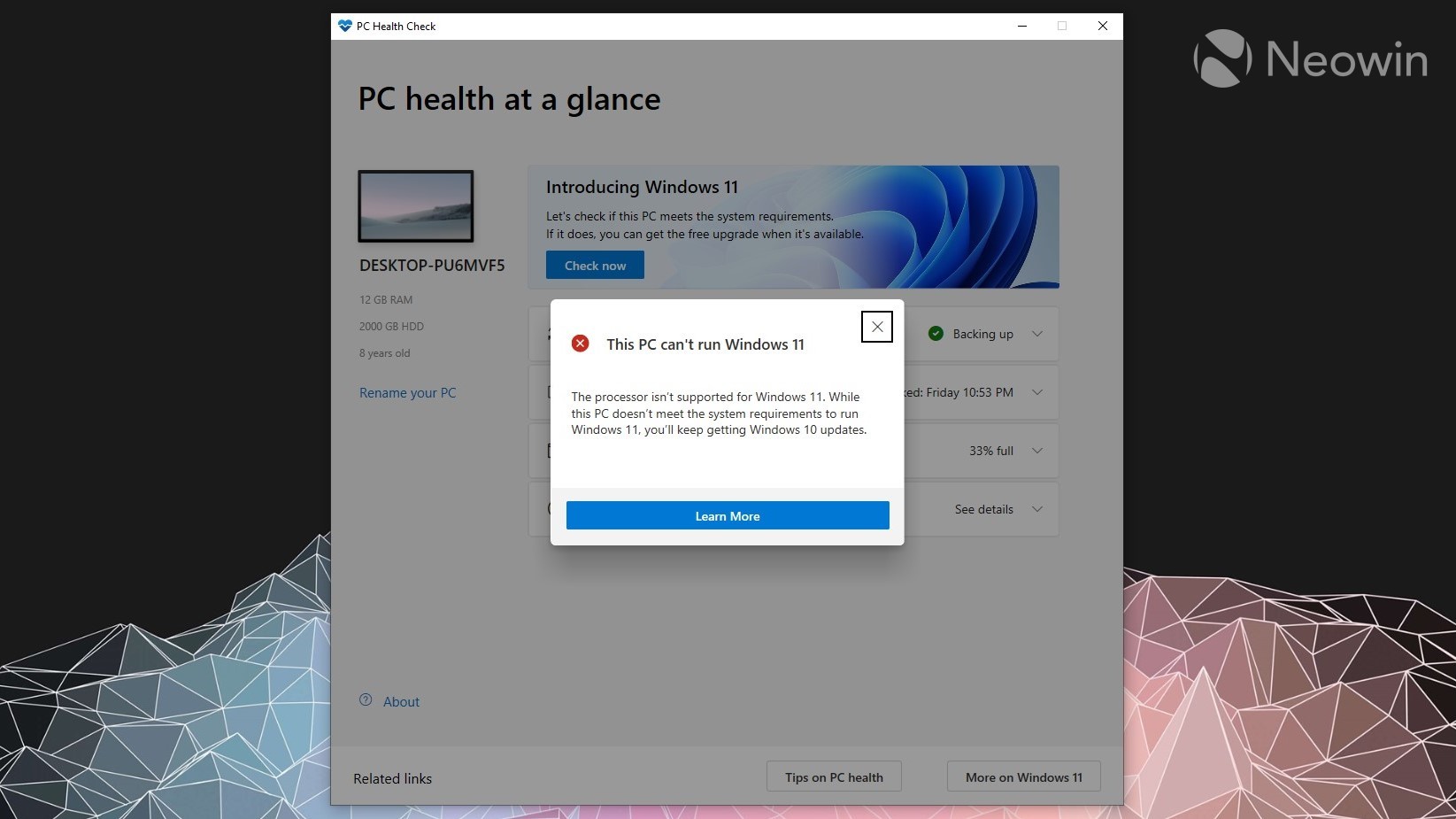
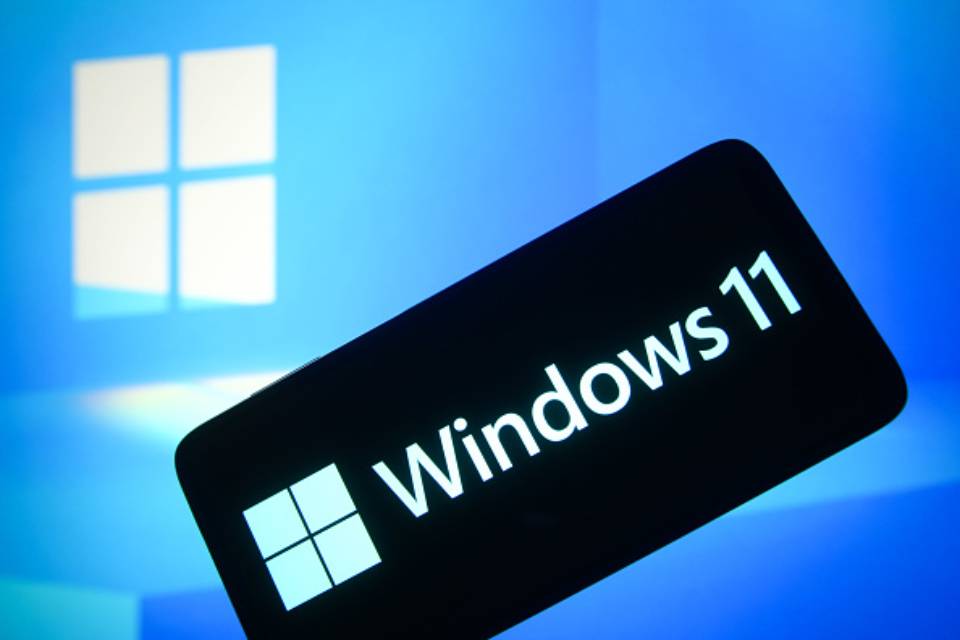

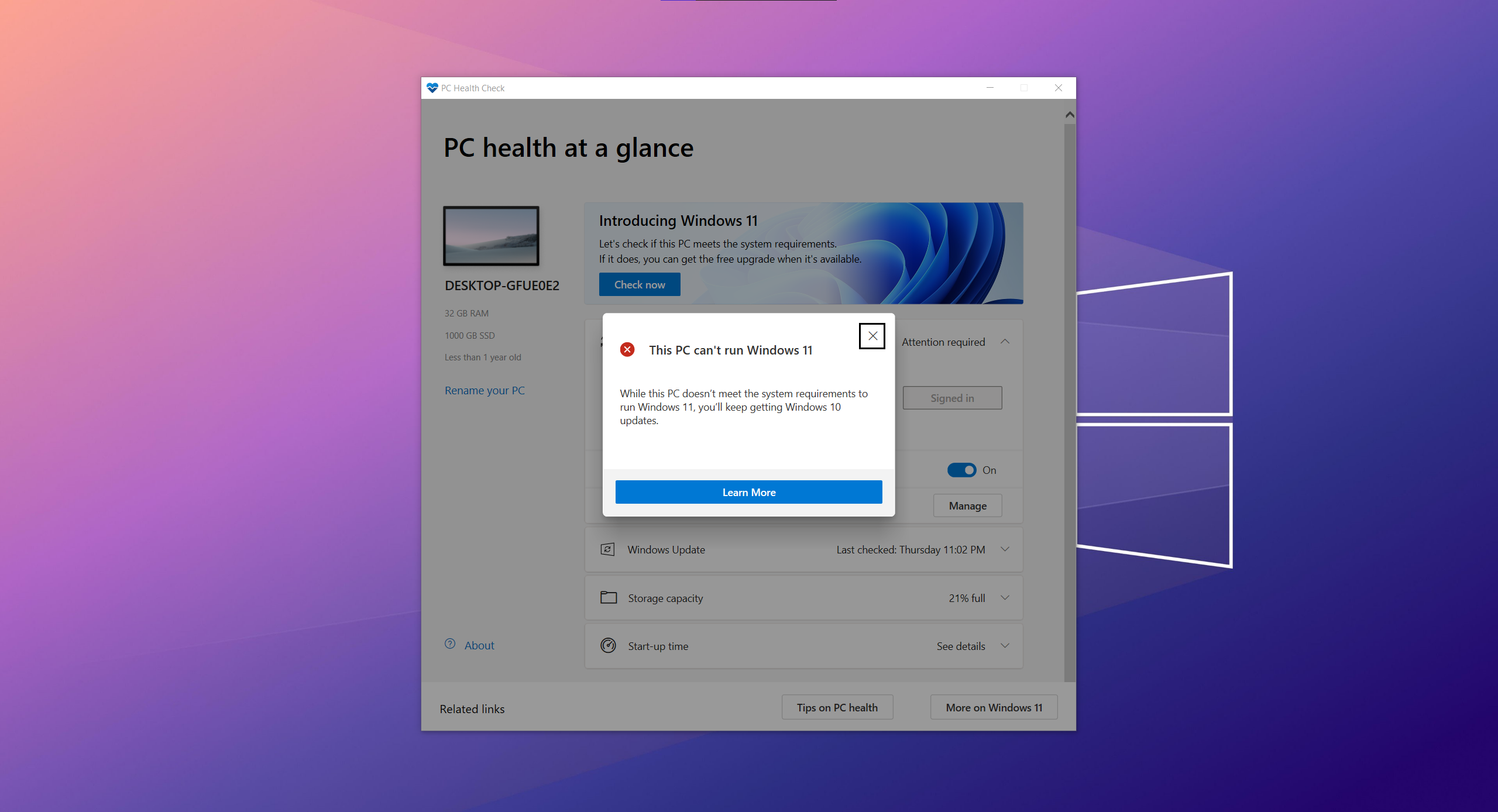
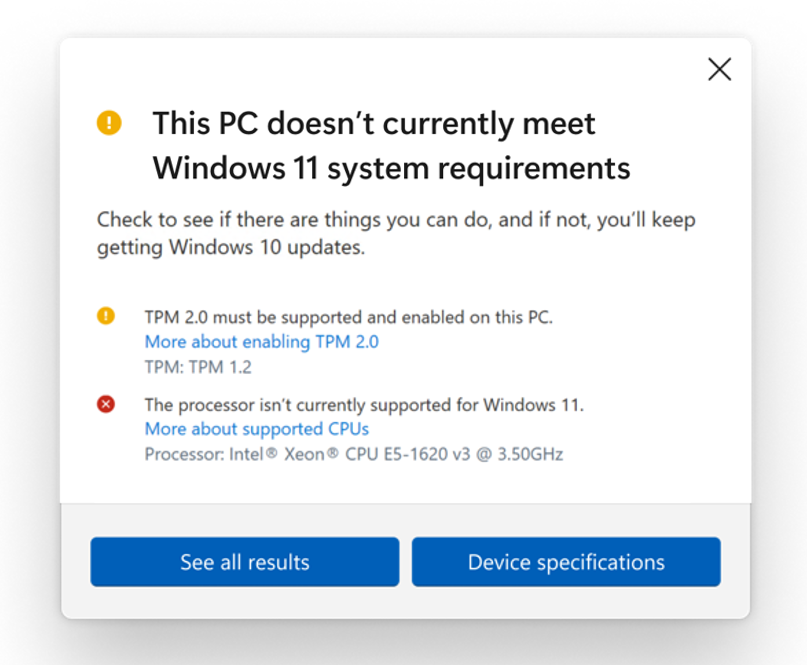




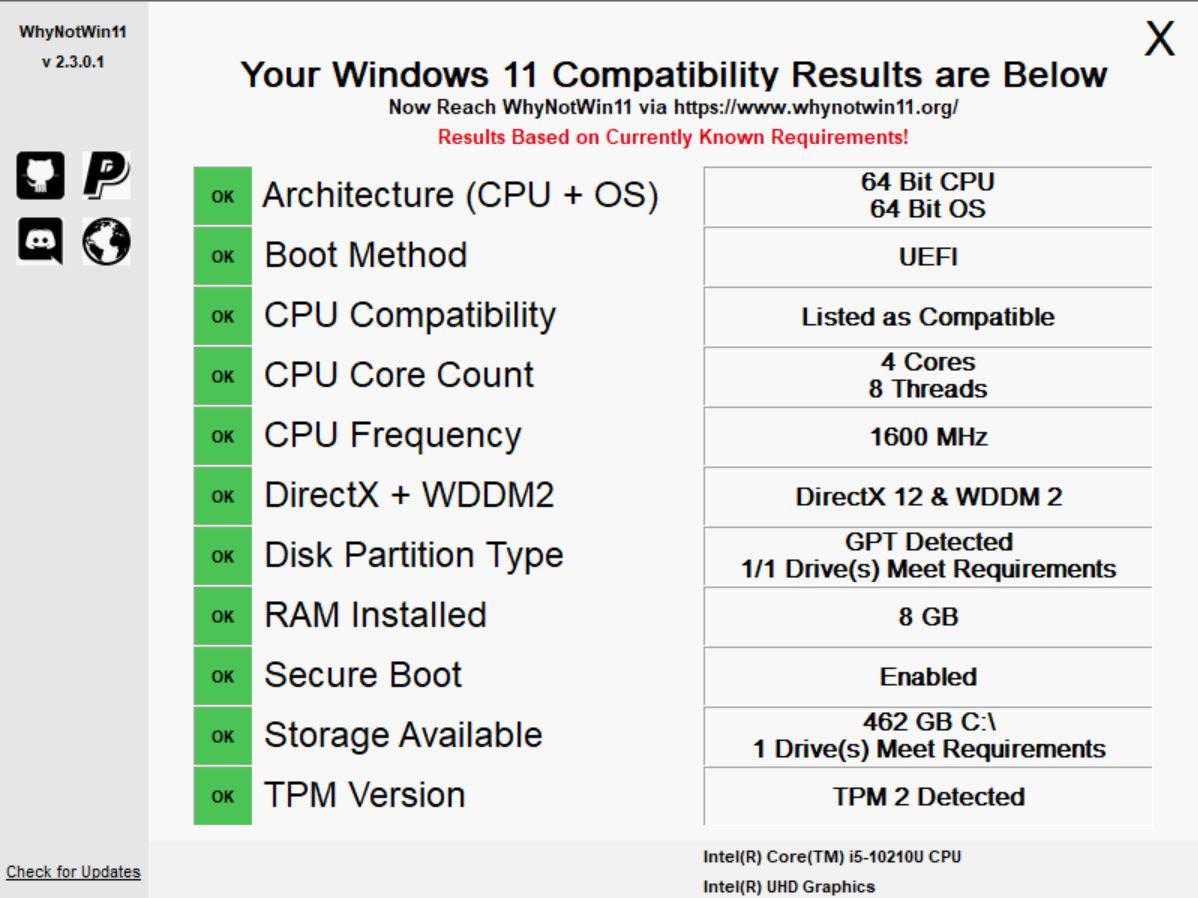

















No comments:
Post a Comment
Note: Only a member of this blog may post a comment.